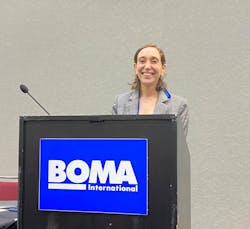Healthy Buildings Can Boost Your CRE Portfolio’s ESG Scores (BOMA 2023)
Sunday morning at the 2023 BOMA International Conference & Expo kicked off with a bang during the educational session titled, “Supercharge Your Building’s ESG Scores to Generate Portfolio-Wide Value.” Environmental, Social and Governance (ESG) factors have rapidly gained momentum in CRE investing in recent years due to growing interest in sustainability among investors, property owners, landlords and tenants, according to professional service provider CBIZ.
“When thinking about ESG reporting, we’re increasingly seeing investors interested and focused on how they can evaluate a company and [they] want reliable, certified, validated information,” she said. Programs like the Center for Active Design’s Fitwel building rating system (or the WELL Building Standard, for example) can go a long way in providing those metrics and assurances to investors on the health and performance of commercial buildings.
Defining Healthy Buildings
For building owners and property managers new to the concept of healthy buildings, Karerat said they can be defined by six evidence-based strategies, including:
- Location. While she admits there is no control over where an existing building is located, “an investor might be able to use this as a screening for questions like, ‘Do I want to invest in this property, because is it going to accrue in value over time?’" Karerat pointed out.
- Design. Things like locating stairs in an optimal location or making sure there is access to daylight or biophilic elements within the interior are simple interventions that can have measurable impact on occupant wellness.
- Operations. Having an emergency preparedness plan and indoor air quality policy (IAQ) are two major considerations, with IAQ being especially critical “because we know how impactful it can be, and it can be implemented in any building,” Karerat said.
- Performance. This is where indoor air quality and water quality testing come into play, which have been proven to have a positive impact on occupants and their satisfaction ratings of buildings, Karerat noted.
- Amenities. These may include fitness studios, quite rooms in an office space and making sure people have a variety of spaces to engage in or access to healthy food options and green spaces, Kareat said.
- Programming and evaluation. How the space is being leveraged to engage the occupants, so is there a physical activity programming onsite, for example.
Connecting Healthy Buildings and ESG
Karerat made a strong case for creating and maintaining healthy buildings and improved ESG scores among investors in commercial real estate. “We are seeing an increase in demand for this area. Even before COVID, we were starting to see the wave rising around folks being more educated around health and wellbeing, and starting to ask questions about, ‘What is my building doing to support occupant health?’ That has only grown in light of COVID,” she said.
Citing a report titled, The New Investor Consensus: A Rising Demand for Healthy Buildings, Karerat shared data indicating how much demand there is for healthy buildings as they relate to ESG among investors today. The study found that:
- 94% of investors report tenant demand for healthy buildings
- 92% of investors expect demand for healthy buildings to continue to grow over the next three years
- 90% of investors are incorporating health and wellness into their strategy, with more than half doing so to a great extent
- 89% of investors plan to enhance their health and wellness strategy
- 74% of investors plan to track data
Top Metrics Investors Are Tracking in CRE
“While there isn’t industry-wide consistency in terms of what people are measuring, there are some themes that starting to emerge,” Karerat said. These are centered around categories in which investors are seeing value when it comes to the connection between the built environment and health, including: tenant satisfaction surveys; walkability, IAQ policies, emergency preparedness and healthy building certification.
Karerat closed the session with a word of caution and a challenge: “Failing to focus on health and wellbeing could result in assets losing out on tenants because properties that do not have a focus on health and wellbeing will be overlooked, resulting in poor economic outcomes. This is what we see as the next wave in value creating, this focus on how building spaces are impacting people,” she said. “The environmental piece ties in so nicely with the social piece, and how can we optimize our spaces looking at it through both of those lenses, and how can they work together to create the most optimal spaces possible?”


